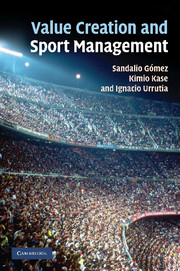Book contents
- Frontmatter
- Dedication
- Contents
- List of figures
- List of tables
- List of contributing authors
- Foreword
- Introduction
- 1 The virtuous circle of value creation in the sports industry
- 2 Value creation and performance criteria for sport entities
- 3 National context and profit strategy of the sport entity
- 4 Value creation in two of the most prestigious Spanish football clubs
- 5 The proto-image of Real Madrid
- 6 Value creation from the organizational structure of a sports entity
- Appendix I Why NGOs matter for the success of sporting events
- Appendix II Strategic evaluation of sponsorship and patronage
- Appendix III Structural characteristics of sport organizations
- Index
- References
6 - Value creation from the organizational structure of a sports entity
Published online by Cambridge University Press: 05 February 2014
- Frontmatter
- Dedication
- Contents
- List of figures
- List of tables
- List of contributing authors
- Foreword
- Introduction
- 1 The virtuous circle of value creation in the sports industry
- 2 Value creation and performance criteria for sport entities
- 3 National context and profit strategy of the sport entity
- 4 Value creation in two of the most prestigious Spanish football clubs
- 5 The proto-image of Real Madrid
- 6 Value creation from the organizational structure of a sports entity
- Appendix I Why NGOs matter for the success of sporting events
- Appendix II Strategic evaluation of sponsorship and patronage
- Appendix III Structural characteristics of sport organizations
- Index
- References
Summary
Introduction
The relationship between the structure and performance of sport-related entities is analysed in this chapter. Using the concept of virtuous circle, namely, the unleashing of a chain of positive reactions, Gómez and Martí shed light on how structures can make best of the value creation process. Types of organizations, challenges and objectives are analysed. Stakeholders are evaluated with regard to their expectations. Financial resources and their linkage to the organizational structure are assessed. Based on the analysis and assessment, an ideal organizational design for sport entities, in this case football clubs, is suggested.
As we pointed out at the beginning of the book, professionalization of sports entities is related to value creation in the sports sector. Sports entities are not only part of the virtuous circle, but they also have an important role to play in how much their financial, sporting and social performance affects whether the circle remains virtuous or becomes vicious. This relationship between the structure and performance of an organization leads us to look at the structural design, in order to ensure that the type of structure is such that it will help these entities create the most value in financial, sporting and social terms.
An organization’s structure is frequently associated with the division and coordination of the tasks and responsibilities, as well as the relationship between this and the running of the organization. Thus, an appropriate structure would include clear lines of authority, correct distribution of responsibilities, as well as effective differentiation and integration to help the organization achieve its goals (Hodge et al., 2003). However, there is no single format that represents the key to success for structuring all organizations, rather this will depend on the individual goals, environment, technology, size and internal culture of each organization. Having said this, the basic aims of a sporting entity and the special characteristics of the sports sector tend to determine the most suitable structural design for this type of entity and the extent to which their operations are oriented towards value creation. We will start by looking at which area has created most value for football clubs in recent years.
- Type
- Chapter
- Information
- Value Creation and Sport Management , pp. 176 - 208Publisher: Cambridge University PressPrint publication year: 2010



